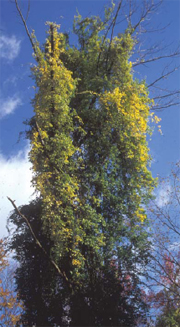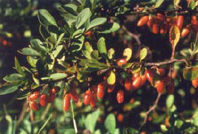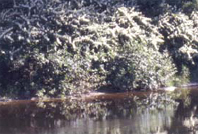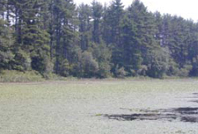Bulletin #2536, Maine Invasive Plants: Invasive Plants Threaten Maine’s Natural Treasures
Developed by the Maine Natural Areas Program and University of Maine Cooperative Extension.
For information about UMaine Extension programs and resources, visit extension.umaine.edu.
Find more of our publications and books at extension.umaine.edu/publications/.
What’s the difference between a “weed” and an “invasive plant”?

A weed is simply a plant growing in a place where it’s not wanted. It might be a problem locally, but it generally doesn’t spread to become a large-scale problem in natural areas.
An invasive plant is a non-native plant with very high reproductive potential and the ability to establish across long distances (for example, it might produce seeds that can spread by wind or by animals). An invasive plant can become established in natural areas, and disrupt natural communities by outcompeting native plants.
Why are invasive plants suddenly a problem?
The invasive plant problem is not new, but the problem is accelerating. Due to a history of low-intensity development and perhaps isolated watersheds, Maine’s landscape has not been ravaged to the same degree as most other New England states. However, our good fortune will be short-lived if invasive plants continue to spread unchecked through our state.
Where do invasive plants come from?
About two-thirds of known invaders have been imported for ornamental and landscape plantings. These species include many of the Northeast’s most troublesome plants: Japanese barberry, oriental bittersweet, Russian olive, Eurasian milfoil, purple loosestrife, and others. Other species have arrived as stowaways: Japanese stilt grass is used in packaging from Japan, and mile-a-minute weed is transported in soil.
What problems do invasive plants cause?
Invasive plants outcompete native species and agricultural crops, causing billions of dollars of damage each year. They affect forests, wetlands, lakes, streams, croplands, and pastures, and degrade many of our sensitive natural habitats. They grow rapidly, multiply, and spread to unmanageable levels in short periods of time.
Invasive species are the second greatest threat to global biodiversity, after the loss of habitat. Invading plants outcompete native species for sunlight, nutrients, and space. They change animal habitat by eliminating native foods, altering cover, and destroying nesting opportunities. Some invaders are so aggressive that they leave no room for our natives.
Invasive plants threaten Maine’s natural and working landscapes. Their aggressive growth degrades our recreational experiences. Species like Japanese barberry and multiflora rose can form thorny, impenetrable thickets in forests. Other invasive plants choke waterways, limiting their use. Invaders increase the costs of agriculture and affect forest regeneration. And, these species mar the natural beauty of our regionally distinctive landscape.
- Porcelain berry swallows the land in Massachusetts.
- Japanese barberry, often used in landscapes, is invading Maine forests.
- Japanese knotweed infests a Kennebec River island.
Are invasive plants being controlled?
Controlling invasive plants is a challenge. Every year, more and more money is needed to combat them. Vermont has spent millions of dollars trying to clear its waterways of just two invasive plants species, Eurasian milfoil, and water chestnut. Florida spends $30 million every year managing invasive plants. Costs in Maine are creeping up as we work to control invaders in our state and national parks. Maine’s Department of Environmental Protection and Department of Inland Fisheries and Wildlife now spend over $1 million each year on management and prevention of infestations of aquatic weeds … and we are just getting started.
- Vermont spends millions each year controlling water chestnut, which has not yet invaded Maine.
- Garlic mustard is gaining a foothold in Maine forests.
What can you do?

Prevention is the key. Until recently, alien plants have benefited from our slow reaction to their damaging impacts. Invaders that are already widespread, like purple loosestrife, are here to stay. But species that have not reached Maine yet, like porcelain berry and mile-a-minute weed, need to be stopped. The damage invasive plants can do is well documented in other New England states. Learn about invasive plants, and avoid them. Your actions can make a difference. Don’t help invaders get around in Maine.
- When buying plants or moving them from place to place, consider whether they are likely to escape. Plants advertised as fast-growing, prolific, and tolerant of many growing conditions are often the ones that become invasive. Maine won’t look like Maine anymore if the plants dominating our landscape are all from away.
- Verify that plants you buy for your yard or garden are not invasive. Ask your local garden supplier to stock more native species.
- Replace invasive plants in your garden with non-invasive alternatives.
- When boating, clean your boat thoroughly before transporting it to a different body of water.
- Volunteer at your local park, refuge or other wildlife areas to help remove invasive species. Help educate others about the problem.
- Learn which plants are problematic in Maine and tell your state representatives that you care about the future of Maine’s natural landscape.
- Our natural landscape is precious. Its future depends on the choices we make.
Where can you find more information?
- University of Maine Cooperative Extension
- Maine Department of Agriculture, Conservation and Forestry / Division of Animal and Plant Health
- Invasive Plant Atlas of New England (IPANE)
Information in this publication is provided purely for educational purposes. No responsibility is assumed for any problems associated with the use of products or services mentioned. No endorsement of products or companies is intended, nor is criticism of unnamed products or companies implied.
© 2005, 2022
Call 800.287.0274 (in Maine), or 207.581.3188, for information on publications and program offerings from University of Maine Cooperative Extension, or visit extension.umaine.edu.
The University of Maine is an EEO/AA employer, and does not discriminate on the grounds of race, color, religion, sex, sexual orientation, transgender status, gender expression, national origin, citizenship status, age, disability, genetic information or veteran’s status in employment, education, and all other programs and activities. The following person has been designated to handle inquiries regarding non-discrimination policies: Director of Equal Opportunity, 101Boudreau Hall, University of Maine, Orono, ME 04469-5754, 207.581.1226, TTY 711 (Maine Relay System).






